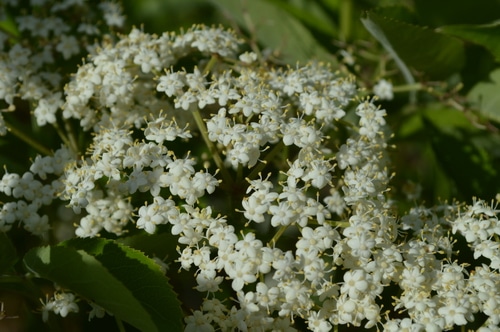Herbal teas can be harvested from the hedgerows, the garden, and the wild lands around you. They are rich in vitamins and minerals as well as active medicines that help your body thrive through the stresses of each season. These 5 fruity herbal teas can be harvested in the summer and are so abundant that you might have overlooked them.
My online friend, Kathie Lapcevic, from Homespun Seasonal Living, is living the DiY lifestyle in Montana, on her one acre homestead. She harvests her own herbal remedies and herbal teas from the garden and the wild forest that surrounds her homestead. These fruity herbal teas are some of Kathie’s favorites. I’m so glad Kathie offered to share them with you and me.
5 Herbal teas from the garden that you may have overlooked
Often when we think of herbal teas and our gardens we think immediately of herbs like mint, lemon balm, hyssop, and others commonly found in our herb beds. However, we shouldn’t neglect our fruit trees and berry patches as sources of tasty and medicinal teas. Consider adding these 5 fruity herbal teas to your tea and medicine chests.

Blackberry
Those leaves that grow wild in many hedgerows and forests are not only tasty but also refreshing and very useful. Blackberry leaves have traditionally been used medicinally to treat diarrhea when infused into a tea.

Infuse 1 teaspoon dried leaves (or 3 teaspoons fresh) with 1 cup boiling water. Let steep 5-10 minutes or to taste. If drinking to treat diarrhea drink one cup every hour until symptoms subside.

Elder Flowers
Elderberries are wildly known and used to help boost the immune system. The elder flowers too have some medicinal uses particularly in moderating excess mucus in the upper respiratory system (Herbal Kitchen). The cold elder flower tea is a diuretic and can help alleviate hot flashes associated with menopause.
Make tea from the flowers by pouring 1 cup of boiling water over 2 tablespoons fresh elder flowers and steeping for 10 minutes. It’s delightful as an iced tea, especially when combined with equal parts mint, so make a big pot and serve over ice, sweeten with honey before cooling if desired.
The flowers can be dried for winter use by simply hanging until crispy and stored in an airtight jar.
Orange Peels
This could work for most any citrus peel but oranges tend to be sweeter and more palatable than lemons or limes to many folks. The peels are loaded with vitamin C and pectin. Pectin is a source of dietary fiber and can be very helpful in feeding the beneficial bacteria in our guts. Because of the high-level of vitamin C the peels can also help shorten the length of colds.

The peels can be dehydrated by placing in a dehydrator until crispy and stored in an airtight container.
To make orange peel tea, use 1 tablespoon dried peels (or 2 tablespoons fresh) per cup of water. If using dried, crush the peels just slightly with a mortar and pestle first. Combine the water and peels in a small saucepan. Bring just to a boil, cover, and turn off heat. Let steep for one hour. Drink warm or cold.
Raspberry Leaves
Raspberry Leaves have long been considered a valuable and useful tonic herb for women especially. Raspberry promotes a tight uterus making it helpful for pregnant women and is often used to help keep risk of hemorrhaging low during child birth. Raspberry leaves are also high in calcium making it a good tea for bone building health. Use the leaves from the first year canes for optimum flavor and medicinal use. First year canes are green and usually don’t produce fruit whereas older canes are woody in appearance and fruit bearing.

Infuse 1 teaspoon dried leaves (or 3 teaspoons fresh) with 1 cup boiling water. Let steep 5-10 minutes or to taste.
Strawberry Leaves
Strawberry leaf tea is believed to relieve anemia and lack of appetite. Like blackberry and raspberry, the leaves can be used dried or fresh and make a refreshing drink both hot and cold.

Infuse 1 teaspoon dried leaves (or 3 teaspoons fresh) with 1 cup boiling water. Let steep for 5 minutes before straining. For an extra delightful summer time drink, crush a fresh berry or two in the bottom of a glass, add ice, and pour the tea over all.
More herbal tea candidates
Chamomile tea
Fiercely D.I.Y.
Creating herbal teas from the things that are growing in your yard or available to you locally is just one of many ways to build a courageous home and live fiercely D.I.Y. Kathie teaches online classes to help you take advantage of the abundance each season has to offer, while still enjoying the solitude and connection with nature. If you are feeling overwhelmed by the sheer workload of each season, and you feel like there must be a better way than this constant treadmill of travelling around the sun at 67,000 miles per hour, Kathie has the keys that can help you step off the treadmill, connect with the season in a more meaningful way, while filling your larder with nourishing, tasty, seasonal foods, herbal remedies, and gifts for each season.
Meet your teacher — Kathie Lapcevic
About Kathie N. Lapcevic
Kathie is a freelance writer, teacher, and blogger living in northwest Montana with her soulmate Jeff. She lives a fiercely D.I.Y. lifestyle in harmony with the natural rhythms of nature. You can follow her blog at Homespun Seasonal Living.
Take a look at her on line classes here.
